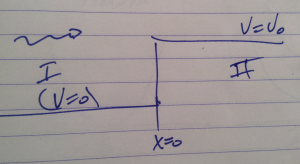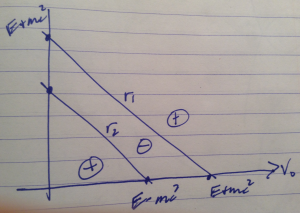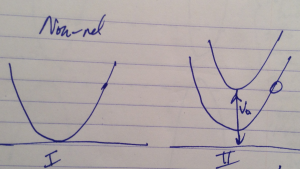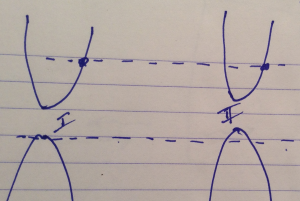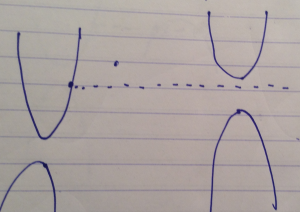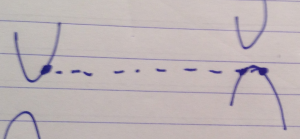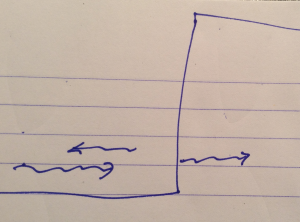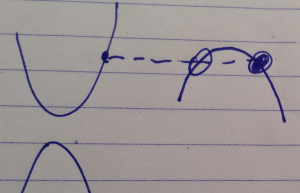[Click here for a PDF of this post with nicer formatting]
The geometric algebra form of Maxwell’s equations in free space (or source free isotopic media with group velocity \( c \)) is the multivector equation
\begin{equation}\label{eqn:planewavesMultivector:20}
\lr{ \spacegrad + \inv{c}\PD{t}{} } F(\Bx, t) = 0.
\end{equation}
Here \( F = \BE + I c \BB \) is a multivector with grades 1 and 2 (vector and bivector components). The velocity \( c \) is called the group velocity since \( F \), or its components \( \BE, \BH \) satisfy the wave equation, which can be seen by pre-multiplying with \( \spacegrad – (1/c)\PDi{t}{} \) to find
\begin{equation}\label{eqn:planewavesMultivector:n}
\lr{ \spacegrad^2 – \inv{c^2}\PDSq{t}{} } F(\Bx, t) = 0.
\end{equation}
Let’s look at the frequency domain solution of this equation with a presumed phasor representation
\begin{equation}\label{eqn:planewavesMultivector:40}
F(\Bx, t) = \textrm{Re} \lr{ F(\Bk) e^{-j \Bk \cdot \Bx + j \omega t} },
\end{equation}
where \( j \) is a scalar imaginary, not necessarily with any geometric interpretation.
Maxwell’s equation reduces to just
\begin{equation}\label{eqn:planewavesMultivector:60}
0
=
-j \lr{ \Bk – \frac{\omega}{c} } F(\Bk).
\end{equation}
If \( F(\Bk) \) has a left multivector factor
\begin{equation}\label{eqn:planewavesMultivector:80}
F(\Bk) =
\lr{ \Bk + \frac{\omega}{c} } \tilde{F},
\end{equation}
where \( \tilde{F} \) is a multivector to be determined, then
\begin{equation}\label{eqn:planewavesMultivector:100}
\begin{aligned}
\lr{ \Bk – \frac{\omega}{c} }
F(\Bk)
&=
\lr{ \Bk – \frac{\omega}{c} }
\lr{ \Bk + \frac{\omega}{c} } \tilde{F} \\
&=
\lr{ \Bk^2 – \lr{\frac{\omega}{c}}^2 } \tilde{F},
\end{aligned}
\end{equation}
which is zero if \( \Norm{\Bk} = \ifrac{\omega}{c} \).
Let \( \kcap = \ifrac{\Bk}{\Norm{\Bk}} \), and \( \Norm{\Bk} \tilde{F} = F_0 + F_1 + F_2 + F_3 \), where \( F_0, F_1, F_2, \) and \( F_3 \) are respectively have grades 0,1,2,3. Then
\begin{equation}\label{eqn:planewavesMultivector:120}
\begin{aligned}
F(\Bk)
&= \lr{ 1 + \kcap } \lr{ F_0 + F_1 + F_2 + F_3 } \\
&=
F_0 + F_1 + F_2 + F_3
+
\kcap F_0 + \kcap F_1 + \kcap F_2 + \kcap F_3 \\
&=
F_0 + F_1 + F_2 + F_3
+
\kcap F_0 + \kcap \cdot F_1 + \kcap \cdot F_2 + \kcap \cdot F_3
+
\kcap \wedge F_1 + \kcap \wedge F_2 \\
&=
\lr{
F_0 + \kcap \cdot F_1
}
+
\lr{
F_1 + \kcap F_0 + \kcap \cdot F_2
}
+
\lr{
F_2 + \kcap \cdot F_3 + \kcap \wedge F_1
}
+
\lr{
F_3 + \kcap \wedge F_2
}.
\end{aligned}
\end{equation}
Since the field \( F \) has only vector and bivector grades, the grades zero and three components of the expansion above must be zero, or
\begin{equation}\label{eqn:planewavesMultivector:140}
\begin{aligned}
F_0 &= – \kcap \cdot F_1 \\
F_3 &= – \kcap \wedge F_2,
\end{aligned}
\end{equation}
so
\begin{equation}\label{eqn:planewavesMultivector:160}
\begin{aligned}
F(\Bk)
&=
\lr{ 1 + \kcap } \lr{
F_1 – \kcap \cdot F_1 +
F_2 – \kcap \wedge F_2
} \\
&=
\lr{ 1 + \kcap } \lr{
F_1 – \kcap F_1 + \kcap \wedge F_1 +
F_2 – \kcap F_2 + \kcap \cdot F_2
}.
\end{aligned}
\end{equation}
The multivector \( 1 + \kcap \) has the projective property of gobbling any leading factors of \( \kcap \)
\begin{equation}\label{eqn:planewavesMultivector:180}
\begin{aligned}
(1 + \kcap)\kcap
&= \kcap + 1 \\
&= 1 + \kcap,
\end{aligned}
\end{equation}
so for \( F_i \in F_1, F_2 \)
\begin{equation}\label{eqn:planewavesMultivector:200}
(1 + \kcap) ( F_i – \kcap F_i )
=
(1 + \kcap) ( F_i – F_i )
= 0,
\end{equation}
leaving
\begin{equation}\label{eqn:planewavesMultivector:220}
F(\Bk)
=
\lr{ 1 + \kcap } \lr{
\kcap \cdot F_2 +
\kcap \wedge F_1
}.
\end{equation}
For \( \kcap \cdot F_2 \) to be non-zero \( F_2 \) must be a bivector that lies in a plane containing \( \kcap \), and \( \kcap \cdot F_2 \) is a vector in that plane that is perpendicular to \( \kcap \). On the other hand \( \kcap \wedge F_1 \) is non-zero only if \( F_1 \) has a non-zero component that does not lie in along the \( \kcap \) direction, but \( \kcap \wedge F_1 \), like \( F_2 \) describes a plane that containing \( \kcap \). This means that having both bivector and vector free variables \( F_2 \) and \( F_1 \) provide more degrees of freedom than required. For example, if \( \BE \) is any vector, and \( F_2 = \kcap \wedge \BE \), then
\begin{equation}\label{eqn:planewavesMultivector:240}
\begin{aligned}
\lr{ 1 + \kcap }
\kcap \cdot F_2
&=
\lr{ 1 + \kcap }
\kcap \cdot \lr{ \kcap \wedge \BE } \\
&=
\lr{ 1 + \kcap }
\lr{
\BE
–
\kcap \lr{ \kcap \cdot \BE }
} \\
&=
\lr{ 1 + \kcap }
\kcap \lr{ \kcap \wedge \BE } \\
&=
\lr{ 1 + \kcap }
\kcap \wedge \BE,
\end{aligned}
\end{equation}
which has the form \( \lr{ 1 + \kcap } \lr{ \kcap \wedge F_1 } \), so the solution of the free space Maxwell’s equation can be written
\begin{equation}\label{eqn:planewavesMultivector:260}
\boxed{
F(\Bx, t)
=
\textrm{Re} \lr{
\lr{ 1 + \kcap }
\BE\,
e^{-j \Bk \cdot \Bx + j \omega t}
}
,
}
\end{equation}
where \( \BE \) is any vector for which \( \BE \cdot \Bk = 0 \).
